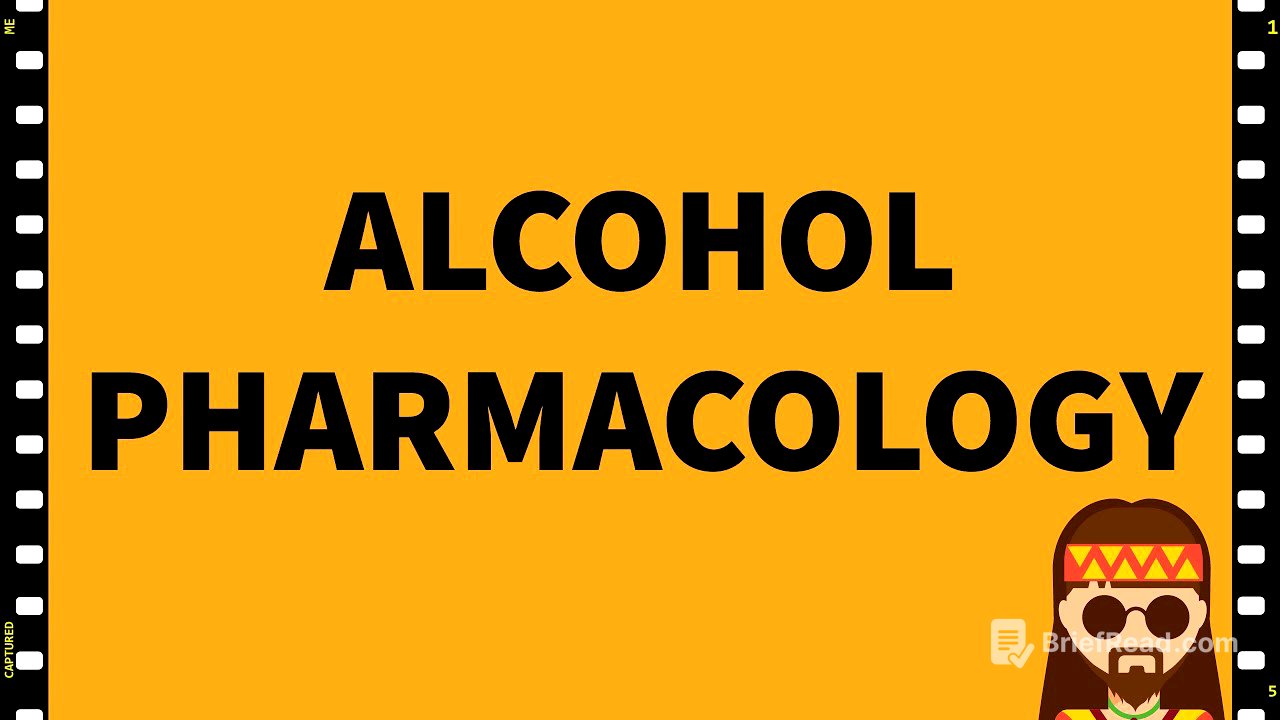TLDR;
This video provides a comprehensive overview of alcohol pharmacology, focusing on the toxicity, chronic alcoholism, and treatments. It explains the effects of alcohol on various body systems, the metabolism of different types of alcohols (methanol, ethylene glycol, and ethanol), and the resulting toxicities. The video also covers the management of alcohol withdrawal, dependence, and acute intoxication, highlighting the mechanisms and uses of drugs like disulfiram, naltrexone, and fomepizole.
- Alcohol affects the CNS, GI tract, liver, kidneys, and cardiovascular system, leading to various health issues.
- Metabolism of methanol, ethylene glycol, and ethanol results in toxic byproducts like formic acid and oxalic acid.
- Treatment strategies include managing withdrawal symptoms, addressing alcohol dependence, and handling acute intoxication with specific antidotes.
Introduction to Alcohol Pharmacology [0:01]
The video introduces the pharmacological aspects of alcohols, focusing on overdose toxicity, chronic alcoholism, and related treatments. It emphasizes understanding the effects of alcohol on different body systems to comprehend its toxicity.
Effects of Alcohol on Body Systems [0:26]
Alcohol's effects on the body are detailed, starting with the central nervous system (CNS), where it initially causes stimulation followed by depression. This is due to the inhibition of inhibitory neurons and facilitation of GABA-A receptors. In the gastrointestinal tract (GIT), alcohol causes irritation and increases gastric acid secretion, potentially leading to gastritis and peptic ulcers. It also acts as an antiseptic by destroying bacterial membranes. Furthermore, alcohol can lower body temperature, cause vasodilation via acetaldehyde, depress the myocardium and vasomotor center, and severely depress respiration. In the liver, alcohol metabolism leads to the production of acetaldehyde, which causes oxidative stress, inflammation, and ultimately cirrhosis. Finally, in the kidneys, alcohol inhibits antidiuretic hormone release, leading to diuresis.
Metabolism of Different Alcohols [2:27]
The video explains the metabolism of methanol, ethylene glycol, and ethanol. Alcohol dehydrogenase converts methanol to formaldehyde, ethylene glycol to glycolaldehyde, and ethanol to acetaldehyde. Aldehyde dehydrogenase then converts formaldehyde to formic acid, glycolaldehyde to glyoxylic acid and then oxalic acid, and acetaldehyde to acetic acid. Alcohol dehydrogenase follows zero-order kinetics due to its dependence on NAD+.
Toxicities of Alcohol Metabolites [3:42]
The toxic effects of alcohol metabolites are discussed. Formic acid, derived from methanol, causes severe respiratory depression, metabolic acidosis, and ocular damage, leading to symptoms like "snowstorm vision." Oxalic acid, from ethylene glycol, also causes respiratory failure and metabolic acidosis, along with the formation of oxalic crystals that result in acute tubular necrosis. Ethanol toxicity presents as acute CNS depression, metabolic acidosis, acute hepatitis, and pancreatitis. Acetaldehyde, a product of ethanol metabolism, causes nausea, vomiting, headache, and hypotension.
Ethanol Toxicity: Acute vs. Chronic [4:50]
Acute ethanol toxicity leads to CNS depression, metabolic acidosis, acute hepatitis, and pancreatitis. Increased acetaldehyde levels cause irritation, nausea, and vomiting. Chronic alcoholism results in fasting hypoglycemia, fatty liver, muscle wasting, increased glucagon, and decreased gluconeogenesis. It also leads to increased lactic acid, which competes with uric acid excretion, causing gout. Wernicke-Korsakoff syndrome, due to thiamine deficiency, is a significant concern, requiring thiamine administration with glucose.
Chronic Alcoholism and Enzyme Induction [7:14]
In chronic alcoholics, the microsomal ethanol oxidizing system (MEOS) becomes active, converting ethanol to acetaldehyde. Chronic alcohol consumption induces p450 enzymes, increasing their activity and synthesis, leading to tolerance. This can result in drug interactions, such as increased conversion of acetaminophen to its hepatotoxic metabolite.
Treatment of Alcohol-Associated Problems [8:17]
The treatment of alcohol-related issues, including withdrawal symptoms, alcohol dependence, and acute intoxication, is outlined. Withdrawal symptoms are managed with thiamine and benzodiazepines like diazepam and chlordiazepoxide (if liver function is normal) or lorazepam (for compromised liver function). Alcohol dependence is treated with disulfiram (which inhibits aldehyde dehydrogenase, causing acetaldehyde accumulation), naltrexone (which decreases the effects of endogenous opioids), and acamprosate (an NMDA receptor antagonist and GABA-A receptor activator).
Management of Acute Alcohol Intoxication [10:12]
For acute methanol or ethylene glycol intoxication, ethanol or fomepizole is administered. Ethanol competes for alcohol dehydrogenase, preventing the formation of more toxic metabolites. Fomepizole is a long-acting inhibitor of alcohol dehydrogenase, preventing the conversion of alcohol into toxic metabolites.









